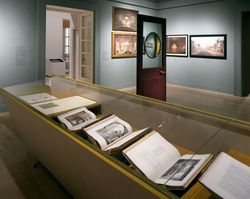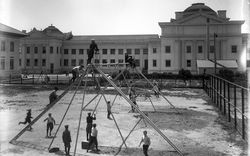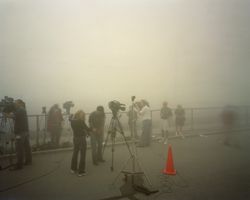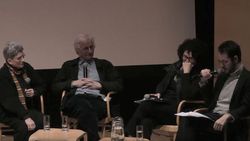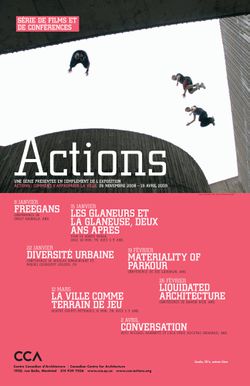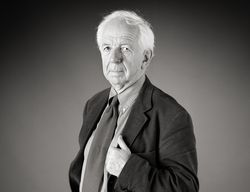John Soane 1753-1837
Described by Henry James as “one of the most curious things in London,” Sir John Soane’s Museum was built as the picturesque and enigmatic home, office, collector’s trove, and personal showplace of one of history’s most innovative architects. This exhibition is a major re-evaluation of Soane’s career, as well as a reconsideration of his importance to the history of modern(...)
Main galleries
16 May 2001 to 3 September 2001
John Soane 1753-1837
Actions:
Description:
Described by Henry James as “one of the most curious things in London,” Sir John Soane’s Museum was built as the picturesque and enigmatic home, office, collector’s trove, and personal showplace of one of history’s most innovative architects. This exhibition is a major re-evaluation of Soane’s career, as well as a reconsideration of his importance to the history of modern(...)
Main galleries
Series
AP184.S1
Description:
Series 1, Three Dimensional Trading Floor, 1990 - 2009, relates to Asymptote Architecture’s design of a virtualized NYSE Trading Floor that visualized real-time numerical and statistical data. This series includes textual, born-digital, and audiovisual components, as well as digital artefacts, and chiefly dates from 1997 to 2002. The intent of the New York Stock Exchange Three Dimensional Trading Floor (3DTF) was to detect suspicious trading activity, track the impact of global news events on the market and potentially predict a crash before it happened. In order to achieve this technically, Asymptote worked with Silicon Graphics Incorporated (SGI) RealityEngine hardware which had been built specifically for these visualization-intensive applications. They also worked with Softimage and Alias software for modeling, rendering and animating, and VRML (Virtual Reality Markup Language) and Macromedia Flash in order to integrate real-time data into a navigable three-dimensional environment. The main elements of the virtual environment include posts, containers, and back wall. The two container types, Index Container (IC) and Group Container (GC), allow for visualization and comparison of stock histories and behaviors. The posts display stock information, corresponding heat maps on floors, and alerts. The back wall integrates live news broadcasts. Materials in this series are largely digital and primarily include still raster images and video demonstrating 3DTF functionality. There is also a small body of CAD material in Maya, Alias, Microstation, and Form-Z formats. Other digital materials include Virtual Reality Markup Language (VRML) files, HTML files, Silicon Graphics Images databases, research material, press kits, presentations, and handout files. The textual records are largely materials that were handed out at presentation meetings for each phase of the project. These typically illustrate major virtual components of 3DTF, like the heat maps and posts, and overlap significantly with the related digital files. There is also one VHS tape which compiles nearly twenty minutes of animated renderings. Finally, this series includes 43 CDs. The CDs were processed and are included as part of the digital records; the CDs themselves were kept in instances where they may have artefactual value, especially if they were visually interesting or informationally important.
1990-2009
Three Dimensional Trading Floor
Actions:
AP184.S1
Description:
Series 1, Three Dimensional Trading Floor, 1990 - 2009, relates to Asymptote Architecture’s design of a virtualized NYSE Trading Floor that visualized real-time numerical and statistical data. This series includes textual, born-digital, and audiovisual components, as well as digital artefacts, and chiefly dates from 1997 to 2002. The intent of the New York Stock Exchange Three Dimensional Trading Floor (3DTF) was to detect suspicious trading activity, track the impact of global news events on the market and potentially predict a crash before it happened. In order to achieve this technically, Asymptote worked with Silicon Graphics Incorporated (SGI) RealityEngine hardware which had been built specifically for these visualization-intensive applications. They also worked with Softimage and Alias software for modeling, rendering and animating, and VRML (Virtual Reality Markup Language) and Macromedia Flash in order to integrate real-time data into a navigable three-dimensional environment. The main elements of the virtual environment include posts, containers, and back wall. The two container types, Index Container (IC) and Group Container (GC), allow for visualization and comparison of stock histories and behaviors. The posts display stock information, corresponding heat maps on floors, and alerts. The back wall integrates live news broadcasts. Materials in this series are largely digital and primarily include still raster images and video demonstrating 3DTF functionality. There is also a small body of CAD material in Maya, Alias, Microstation, and Form-Z formats. Other digital materials include Virtual Reality Markup Language (VRML) files, HTML files, Silicon Graphics Images databases, research material, press kits, presentations, and handout files. The textual records are largely materials that were handed out at presentation meetings for each phase of the project. These typically illustrate major virtual components of 3DTF, like the heat maps and posts, and overlap significantly with the related digital files. There is also one VHS tape which compiles nearly twenty minutes of animated renderings. Finally, this series includes 43 CDs. The CDs were processed and are included as part of the digital records; the CDs themselves were kept in instances where they may have artefactual value, especially if they were visually interesting or informationally important.
Series
1990-2009
articles
Playing it Safe
Keep Safe
Keep Safe, playgrounds, safety, risk, regulation, public space, control, contemporary playground design,
8 July 2024
Playing it Safe
Delara Rahim, Francisco Brown, Jimmy Pan, and Angie Door on the creation of play subjects and playgrounds
Actions:
Keep Safe
Dieter Appelt: The Catastrophe of Things presents images of the attic of the Künstlerhaus Bethanien in Berlin. Fascinated by sites charged with history, German artist Dieter Appelt uses his examination of the attic to inquire into the invisible, mysterious, and indefinite forces of decay that lie beyond everyday experience. By concentrating on structural details, and by(...)
Octagonal gallery
17 April 1996 to 4 August 1996
Dieter Appelt: The Catastrophe of Things
Actions:
Description:
Dieter Appelt: The Catastrophe of Things presents images of the attic of the Künstlerhaus Bethanien in Berlin. Fascinated by sites charged with history, German artist Dieter Appelt uses his examination of the attic to inquire into the invisible, mysterious, and indefinite forces of decay that lie beyond everyday experience. By concentrating on structural details, and by(...)
Octagonal gallery
Robert Burley, CCA Mellon Senior Fellow and Assistant Professor at Ryerson University, speaks on “The Architecture of Photography in an Age of Obsolescence.” The CCA Mellon Foundation Senior Fellowship Program was established in 2001 to encourage advanced research in architectural history and thought. With the generous support of The Andrew W. Mellon Foundation,(...)
Paul Desmarais Theatre
16 September 2010, 6pm
Robert Burley: The Architecture of Photography in an Age of Obsolescence
Actions:
Description:
Robert Burley, CCA Mellon Senior Fellow and Assistant Professor at Ryerson University, speaks on “The Architecture of Photography in an Age of Obsolescence.” The CCA Mellon Foundation Senior Fellowship Program was established in 2001 to encourage advanced research in architectural history and thought. With the generous support of The Andrew W. Mellon Foundation,(...)
Paul Desmarais Theatre
events
Publisher and graphic designer Lars Müller discusses his work and the implications of producing books in the digital age. The lecture also addresses collaborations between Lars Müller Publishers and the CCA, and is held on occasion of the publication of the exhibition catalogue Some Ideas on Living in London and Tokyo by Stephen Taylor and Ryue Nishizawa (2008). The book(...)
Paul Desmarais Theatre
18 September 2008 , 6pm
Lars Müller: If this was not the End, what is the Future of Print?
Actions:
Description:
Publisher and graphic designer Lars Müller discusses his work and the implications of producing books in the digital age. The lecture also addresses collaborations between Lars Müller Publishers and the CCA, and is held on occasion of the publication of the exhibition catalogue Some Ideas on Living in London and Tokyo by Stephen Taylor and Ryue Nishizawa (2008). The book(...)
events
18 September 2008
6pm
Paul Desmarais Theatre
None
14 December 2017
Eve Blau, Richard Pare, and Phyllis Lambert on Photographic Evidence
Actions:
Description:
None
Liquidated Architecture
American urban planner and designer Damon Rich examines the links among politics, architecture, and history. His research analyses the evolution of the real estate market – foreclosures, mortgages, construction and zoning. He is also a collaborator of the Center for Urban Pedagogy (CUP), an organization based in Brooklyn that studies movements within cities and their(...)
Paul Desmarais Theatre
26 February 2009
Liquidated Architecture
Actions:
Description:
American urban planner and designer Damon Rich examines the links among politics, architecture, and history. His research analyses the evolution of the real estate market – foreclosures, mortgages, construction and zoning. He is also a collaborator of the Center for Urban Pedagogy (CUP), an organization based in Brooklyn that studies movements within cities and their(...)
Paul Desmarais Theatre
PH1978:0038:001
Description:
Album containing 100 photogravures made from photographs by Baldus following a special process of his own, that would restore them on the reverse side. Malcolm Daniel writes: "Baldus's Louvre photographs found their final incarnation in a gravure publication 'Palais du Louvre et des Tuileries'. The three volumes in this set largely parallel the albums that Baldus had made earlier for the Minister of State; again the majority of the images are of sculptural and ornamental details from the New Louvre, but statuary and ornament from the Tuileries Palace and Gardens are also included. The first edition of the 'Palais du Louvre et des Tuileries', published by Baldus himself, was offered for sale in fascicles beginning in late 1869, and the series was completed by the end of 1871. Two volumes, each with 100 plates, focused on interior and exterior decoration. Because of the success of the first two volumes, a third, showing both interior and exterior motifs was produced, and the three-volume set was published by Morel in 1875." ('History of Photography', p. 120-121). In this album, views show sculptural and ornamental details (some of them fragments) of the models made for the decoration of the Manège; Palais des Tuileries (south wing, court façade); quay façade); the New Louvre (south wing, Carrousel façade and quay façade); Guichet de l'Empereur; Pavillon de Flore (quay façade); first floor; Lesdiguières, Turgot and Rohan Pavilions and a view of the Pavillon des Tuileries before destruction by fire by the Commune.
architecture, ornament, sculpture
1869-1871
Palais du Louvre et des Tuileries. Motifs de décorations tirés des constructions exécutées au nouveau Louvre et au palais des Tuileries sous la direction de M.H.-M. Lefuel, architecte de l'empereur.
Actions:
PH1978:0038:001
Description:
Album containing 100 photogravures made from photographs by Baldus following a special process of his own, that would restore them on the reverse side. Malcolm Daniel writes: "Baldus's Louvre photographs found their final incarnation in a gravure publication 'Palais du Louvre et des Tuileries'. The three volumes in this set largely parallel the albums that Baldus had made earlier for the Minister of State; again the majority of the images are of sculptural and ornamental details from the New Louvre, but statuary and ornament from the Tuileries Palace and Gardens are also included. The first edition of the 'Palais du Louvre et des Tuileries', published by Baldus himself, was offered for sale in fascicles beginning in late 1869, and the series was completed by the end of 1871. Two volumes, each with 100 plates, focused on interior and exterior decoration. Because of the success of the first two volumes, a third, showing both interior and exterior motifs was produced, and the three-volume set was published by Morel in 1875." ('History of Photography', p. 120-121). In this album, views show sculptural and ornamental details (some of them fragments) of the models made for the decoration of the Manège; Palais des Tuileries (south wing, court façade); quay façade); the New Louvre (south wing, Carrousel façade and quay façade); Guichet de l'Empereur; Pavillon de Flore (quay façade); first floor; Lesdiguières, Turgot and Rohan Pavilions and a view of the Pavillon des Tuileries before destruction by fire by the Commune.
architecture, ornament, sculpture
Hubert Damisch, 2003-2004 CCA Mellon Senior Fellow, examines Blur – the cloud building created by New York architects Diller + Scofidio on lake Neuchâtel in Switzerland, which is the most recent and radical expression of the desire for fluidity and evanescence in architecture – and the consequences that it might have on the future of structural thought. Damisch examines(...)
Paul Desmarais Theatre
8 May 2003
Hubert Damisch: “Effacer l’architecture?”
Actions:
Description:
Hubert Damisch, 2003-2004 CCA Mellon Senior Fellow, examines Blur – the cloud building created by New York architects Diller + Scofidio on lake Neuchâtel in Switzerland, which is the most recent and radical expression of the desire for fluidity and evanescence in architecture – and the consequences that it might have on the future of structural thought. Damisch examines(...)
Paul Desmarais Theatre
